Omega Sports Watches
Omega Sports Watches: The Ultimate Guide
Omega has been the official timekeeper of the Olympic Games since 1932, and the brand has already released a number of special Olympic-themed Omega watches to celebrate Tokyo 2020 and Beijing 2022. However, in addition to the various Olympic edition watches that the brand produces to commemorate events, Omega is also one of the world's most famous manufacturers of luxury sports watches.
From producing the official flight-qualified watch of NASA to the official timepiece worn by James Bond, Omega sports watches have been worn on the bottom of the ocean, the surface of the moon, and everywhere in between. In fact, the Omega Speedmaster is still the go-to watch for today's astronauts, and it is a prototype Seamaster that currently holds the title of being the watch that has traveled deeper below the surface of the ocean than any other timepiece. Omega may be one of the world's most famous luxury manufacturers but sports watches are an important part of the brand's DNA, and among the four main collections that make up Omega's entire catalog, two of them pertain almost exclusively to sports models. To celebrate the start of the world's biggest sporting event, we are taking a closer look at the different Omega sports watches that are currently available.
For well over 100-years now, two of the world's greatest watchmaking houses, Omega and Rolex, have been locked in a fierce rivalry, each racking up scores of groundbreaking horological advances in a relentless game of one-upmanship. Their respective catalogs are teeming with watches that have repeatedly earned that hardest working of epithets - 'iconic' - and both brands have become inextricably linked with many of history's biggest moments and some of pop culture's most enduring stars. However, while Rolex's playbook has maintained an unwavering design core for decades, Omega watches have displayed a far greater experimental edge.
Omega's willingness to venture away from its own well-established foundations hasn't always produced winners, and the quartz crisis of the 70s and 80s certainly hit Omega harder. With that in mind, over the last 30-years or so, Omega has been an incredible resurgence and today produces a wide variety of watches that can go toe-to-toe with offerings from just about any other brand. Omega has scored triumph after triumph in all three of the most crucial fields for any watch company; styling, engineering, and marketing.
Omega the only manufacturer to recognize the genius of George Daniel's Co-Axial escapement - now considered to be the most significant development in the workings of the mechanical watch movement for over two centuries. Omega also introduced its own Master Chronometer certification, an enormously stringent standard for timekeeping accuracy overseen by METAS (the Swiss Federal Institute of Meteorology). The endorsement sees Omega's calibers accurate to within -0/+5 seconds a day, and resistant to magnetic fields of up to 15,000 gauss. And, perhaps even more momentously than all of that, Omega got its products onto the wrist of the best advertisement any watchmaker has ever had, James Bond.
Far from slowing down, Omega has continued to invent and remodel, forever pushing the boundaries - and nowhere more so than with its diverse fleet of sports watches. Two of the four collections in its contemporary lineup - the Speedmaster and Seamaster - can be classified as 'sports watches' and both of them are further divided into several distinct (and occasionally confusing) sub-collections.
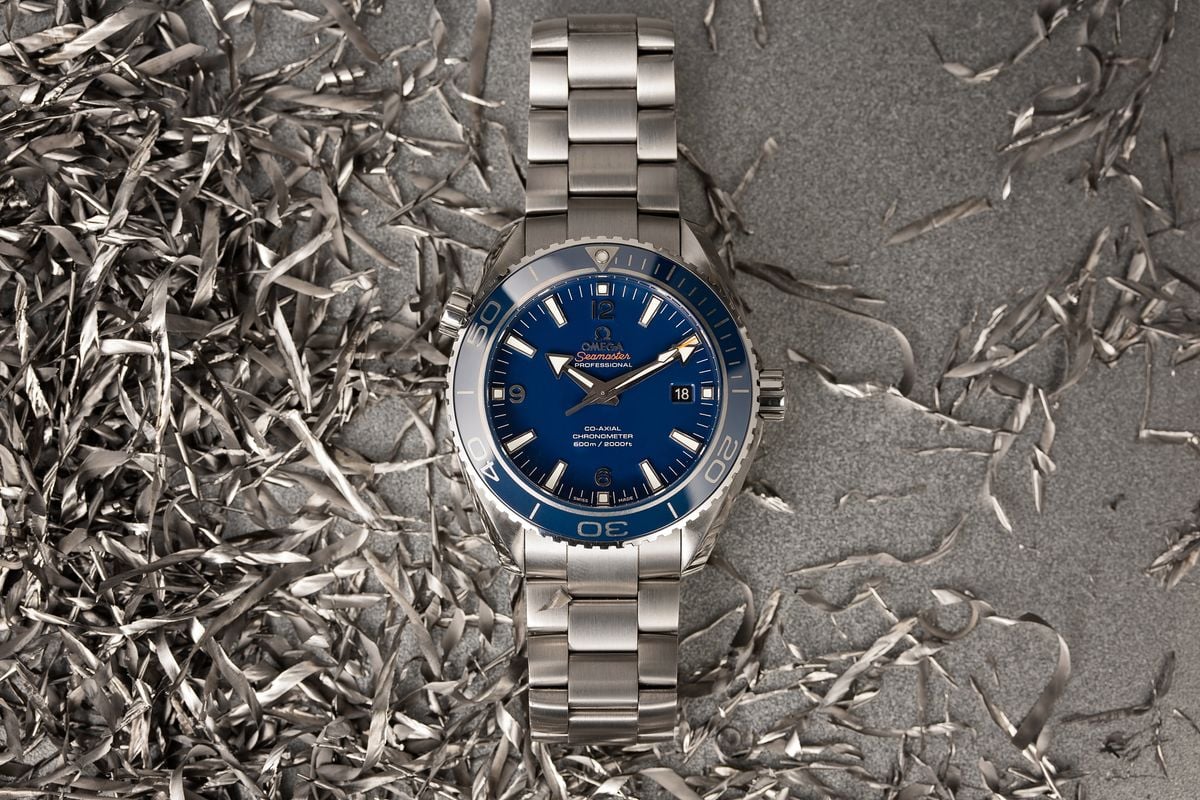 How well do you know the different Omega sports watches?
How well do you know the different Omega sports watches?
What is a Sports Watch?
Much like a tool watch (and the two terms are often used interchangeably), a sports watch is one that is designed with a focus on legibility, strength, and resilience, often with extra functionality to help complete a specific job or operate within a specific environment. For instance, chronographs qualify, due to their ability to time laps (or anything else), as do dive watches because they are designed with high levels of water-resistance and are typically fitted with rotating timing bezels.
These days, there is actually a fairly broad description attached to the phrase ‘sports watch' and it tends to encompass any overtly robust piece or one that is not visibly dressy. That being said, some of the most well-known and admired examples are those which have a particular aesthetic versatility and can be worn with anything from t-shirt and jeans through to a full-on tuxedo.
The sports watch genre is one that really came to the fore during the 1950s and one which has remained exceptionally popular ever since. Omega can claim much of the praise for promoting and maintaining that esteem, with a host of models such as the Omega Seamaster and Speedmaster that captured the imagination and which have become legendary in the industry.
Omega and Sports
Omega's relationship with the world of sports goes back to the turn of the 20th century. The brand's range of pocket watches was the first choice for many of the sanctioned sporting events throughout Switzerland, and Omega's history as Official Timekeeper of the Olympic Games dates all the way back to 1932.
In 1948, Omega was responsible for introducing electronic timing to the event, linking one of their timepieces to a remotely operated camera, and recording the first-ever photo finish during the 100m at the London games. That was also the year that saw Omega launch a name that has since gone on to become one of the most famous of them all; the Seamaster.
The original model, the CK2518 was actually based on the watches the brand had supplied to airmen during WWII, a civilian version of the CK2129. A simple, uncluttered, time-only piece, it proved to be a hit with the public and was among the first models to use rubber O-ring gaskets to improve water resistance. Even so, it was a world away (visually speaking) from the next generation of watches to bear the Seamaster title, one of three models that would lay the groundwork for Omega's success for a generation.
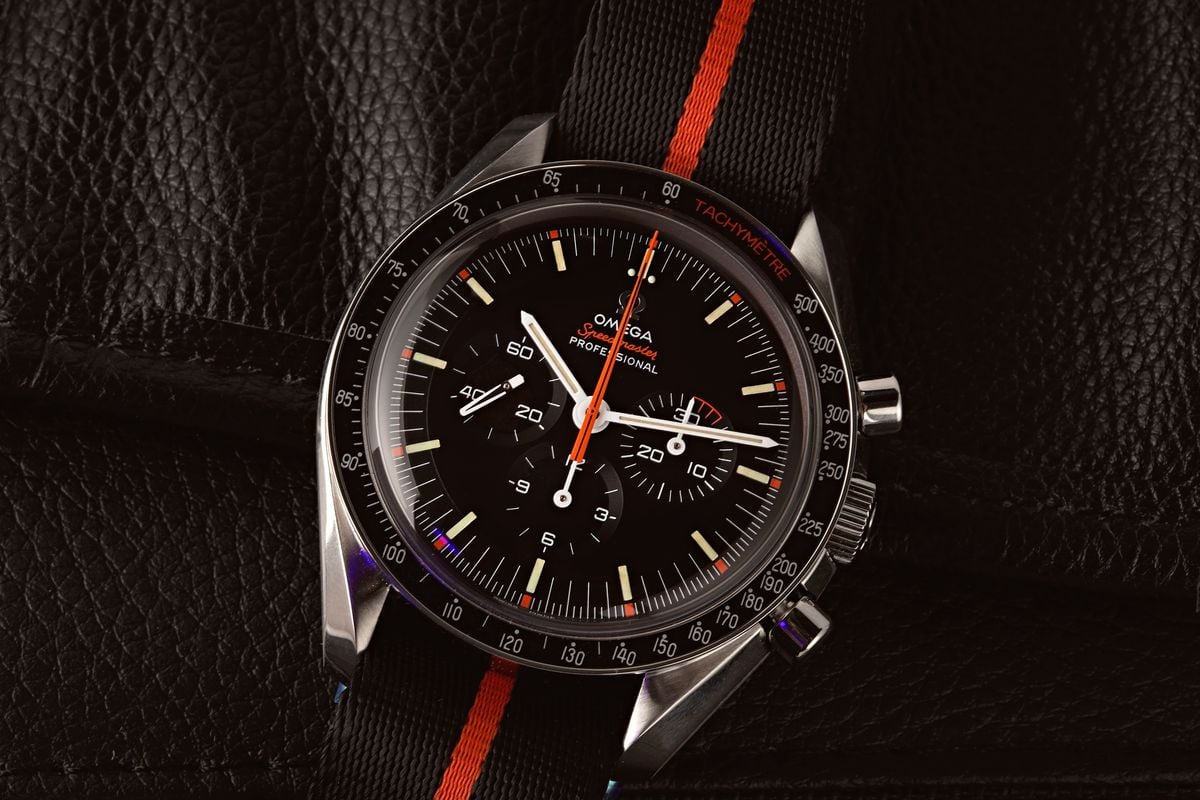 Omega produces a number of limited-edition watches each year.
Omega produces a number of limited-edition watches each year.
A Trilogy of Omega Sports Watches
The 1950s were a great time to be a watch designer. The post-war years brought groundbreaking new technologies and with them, a raft of new hobbies and pastimes. Catering to all this with timepieces robust enough to cope with these new and extreme conditions pushed watch manufacturers to previously unthought-of heights.
Omega concentrated on producing watches that could be worn during the fledgling sport of scuba diving, with Jacques Cousteau's creation of the aqualung opening up the beauty of the subaquatic world, as well as a model destined for the exhilarating world of the race track, and another watch capable of overcoming a problem that had plagued mechanical watches for generations - the disruptive effects of electromagnetic fields.
These three watches - the Omega Seamaster 300, the Omega Speedmaster and the Omega Railmaster - were released simultaneously in 1957, and became known as Omega’s Professional Collection. Each one has had a fascinating history, and modern-day versions continue to remain a part of the brand's catalog to this day, with some of them being the most accomplished sports watches ever made.
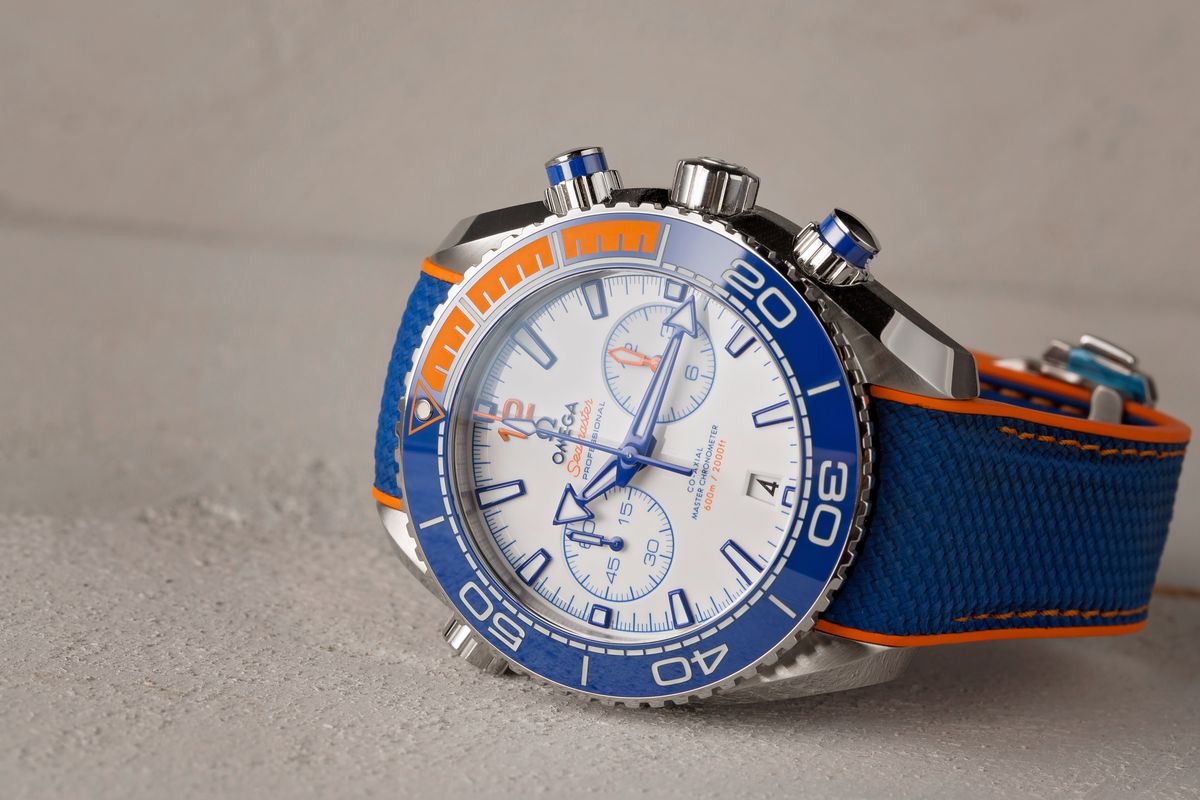 The Seamaster is Omega's collection of water-resistant timepieces.
The Seamaster is Omega's collection of water-resistant timepieces.
The Omega Seamaster Collection
The debate as to whether Rolex or Omega produces the best luxury dive watch is one that has raged for nearly 70-years, and one that will never be truly won. Both brands have long and illustrious histories in the field, with Rolex's Submariner debuting in 1953, four years before Omega introduced the Seamaster 300 ref. CK2913 - the first purpose-built dive watch models from Omega to bear the 'Seamaster' name. However, while Rolex's underwater collection has remained fairly modest over the years, the Omega Seamaster series has splintered into a bewildering number of different models, across a highly diverse range of styles.
It sometimes seems any watch Omega can't find another place for will get pushed into the greater Seamaster catalog. Consequently, we now have a strange situation where even the Railmaster, a watch initially designed for scientists and engineers, is now officially the Seamaster Railmaster. However, alongside that oddity, there lie some of the most capable and appealing dive watches of the modern era. Below, we give a rundown of the current Omega Seamaster range.
Omega Seamaster 300 (21 models)
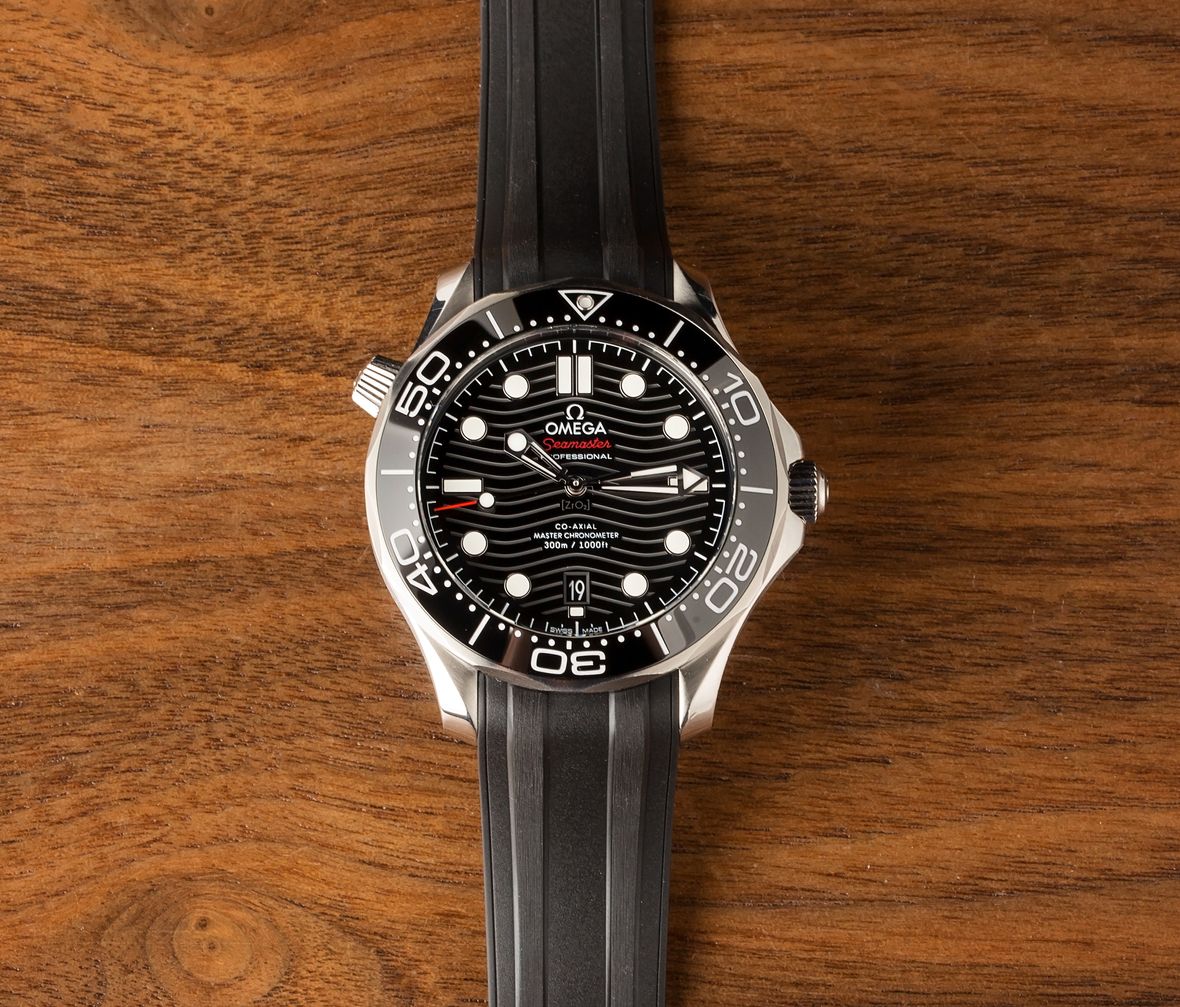 Key Features:
Key Features:
- Year of Introduction: 1957; 1993
- 41mm case diameter
- 300 meters / 1,000 Feet of water resistance
- Unidirectional timing bezel; Luminous hands and hour markers
- Time-only display
- Vintage-inspired aesthetics
Check out our guide to understanding the Omega Seamaster collection here.
The vintage-inspired Omega Seamaster 300 brings us back to the original Submariner rival from 1957. However, while some Omega watches are near identical recreations of the original models to which they pay tribute, the current Omega Seamster 300 takes the general design of the inaugural model and reimages it for the modern era. At 41mm, it is a couple of mills larger than the original, and it also has a noticeably thicker bezel crafted from high-tech Liquidmetal.
Power throughout the range is supplied by Omega’s Master Co-Axial movements, and you can take your pick from a variety of dial colors and case metals, including stainless steel, 18k gold, two-tone steel and gold, titanium, and platinum, along with a number of different dial and strap/bracelet combinations.
The Omega Seamaster is one of the oldest names in Omega's catalog, with a rich history that dates all the way back to 1948. However, for the first decade of its life, the Seamaster collection was simply a range of water-resistant dress watches, and it would not be until 1957 that the Seamaster series would include its first purpose-built dive model. Today, the Omega Seamaster is easily the brand's most diverse collection, and it now consists of numerous sub-collections that span everything from professional divers to vintage-inspired dress watches. However, despite this variety, the Seamaster collection still contains the majority of Omega's sports watches, including all of its divers and other water-related sports models.
The very first Omega dive watch from 1957 was the Seamaster 300 and today, the brand produces a modern version of that same watch, which draws its general design inspiration from the inaugural model from the 1950s. While the overall aesthetics of the watch are firmly rooted in its past, the contemporary Omega Seamaster 300 is merely a vintage-inspired model rather than being a direct carbon copy. What this means is that the Seamaster 300 benefits from modern technologies and conveniences such as a scratch-resistant sapphire crystal and a state-of-the-art antimagnetic movement that boasts chronometer certification.
Another incredibly popular professional dive watch from the greater Seamaster collection is the Omega Seamaster Diver 300M. Unlike the Seamaster 300, which is a modern rendition of a retro design, the Diver 300M is a thoroughly modern sports watch, with the very first iterations of the model only making an appearance in 1993. An older version of the Seamaster Diver 300M can be spotted on James Bond’s wrist throughout all of the Brosnan-era films and unlike the Seamaster 300, it features a helium escape valve that allows it to be used for saturation diving. While the Seamaster Diver 300M offers all the features required of a highly capable dive watch, it also includes a refined design that does not look out of place in the slightest when paired with formal attire, and this makes it a great candidate for the go-anywhere, do-anything type of watch.
Omega Seamaster Professional Diver 300M (49 models)
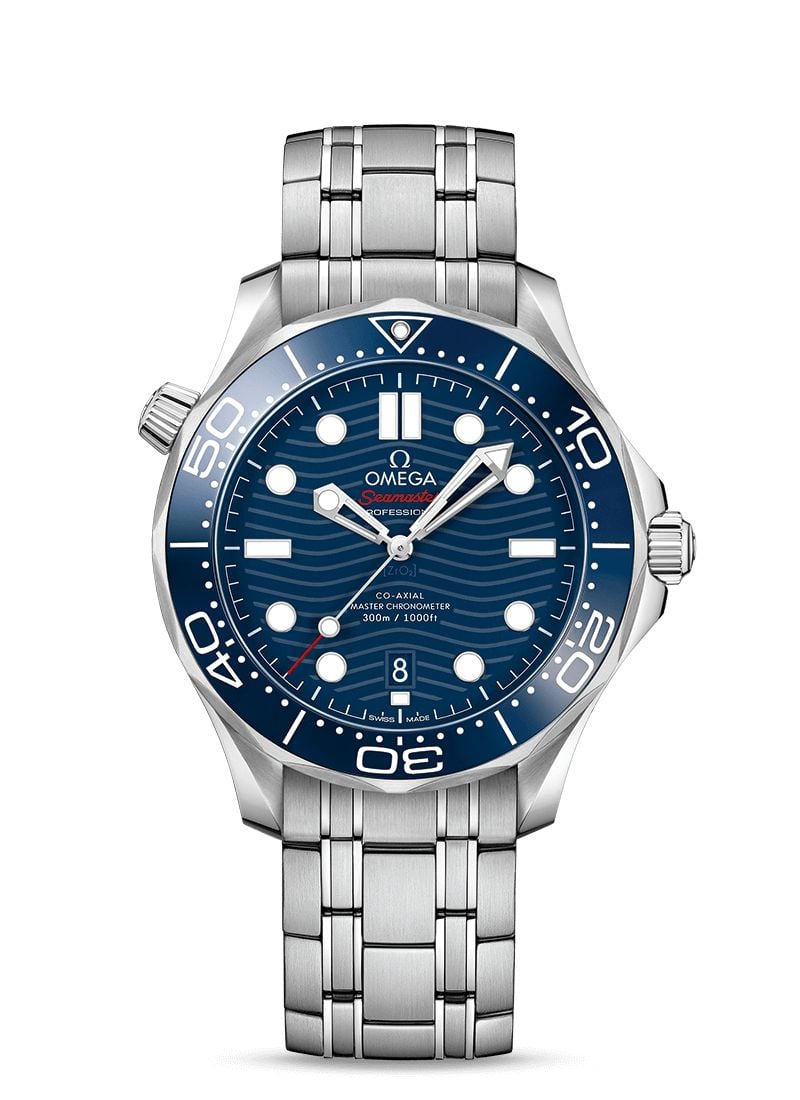
Key Features:
- Multiple case size options
- 300 meters of water resistance
- Unidirectional timing bezel
- Helium gas escape valve
- Chronograph and GMT models available
If there is one watch you can point to that brought Omega back from the brink, the Seamaster Professional Diver 300M is it. In a massive coup for the brand, the Seamaster Diver 300M stole Rolex's favorite client when Pierce Brosnan strapped on his blue dial and bezel, quartz-powered Omega Seamaster Diver 300M in 1995's Goldeneye, during his first outing as James Bond. The watch instantly became the most sought-after Omega watch in the world, and there has been an Omega on Agent 007's wrist ever since.
Not to be confused with the Seamaster 300 above (and you do sometimes wish Omega was a bit more imaginative with its names), there are now 49 different Seamaster Diver 300M models in the current collection, including the various limited edition watches. The current Omega Seamaster Diver 300 range includes everything from time-only models to chronographs and GMT watches.
One of the most diverse assortments available from Omega, there is also a choice of sizes, ranging from 41mm up to 44mm, and all are equipped with helium escape valves and contain advanced Co-Axial movements, with the majority holding 'Master Chronometer' certification status as well.
The Omega Seamaster Professional Diver 300M plays heavily on its James Bond association, with modern versions of Brosnan’s original blue model still available, alongside the new titanium version with its matching mesh bracelet that will be worn by Daniel Craig as Agent 007 in the upcoming Bond film, No Time to Die.
Omega Seamaster Planet Ocean 600M (121 models)
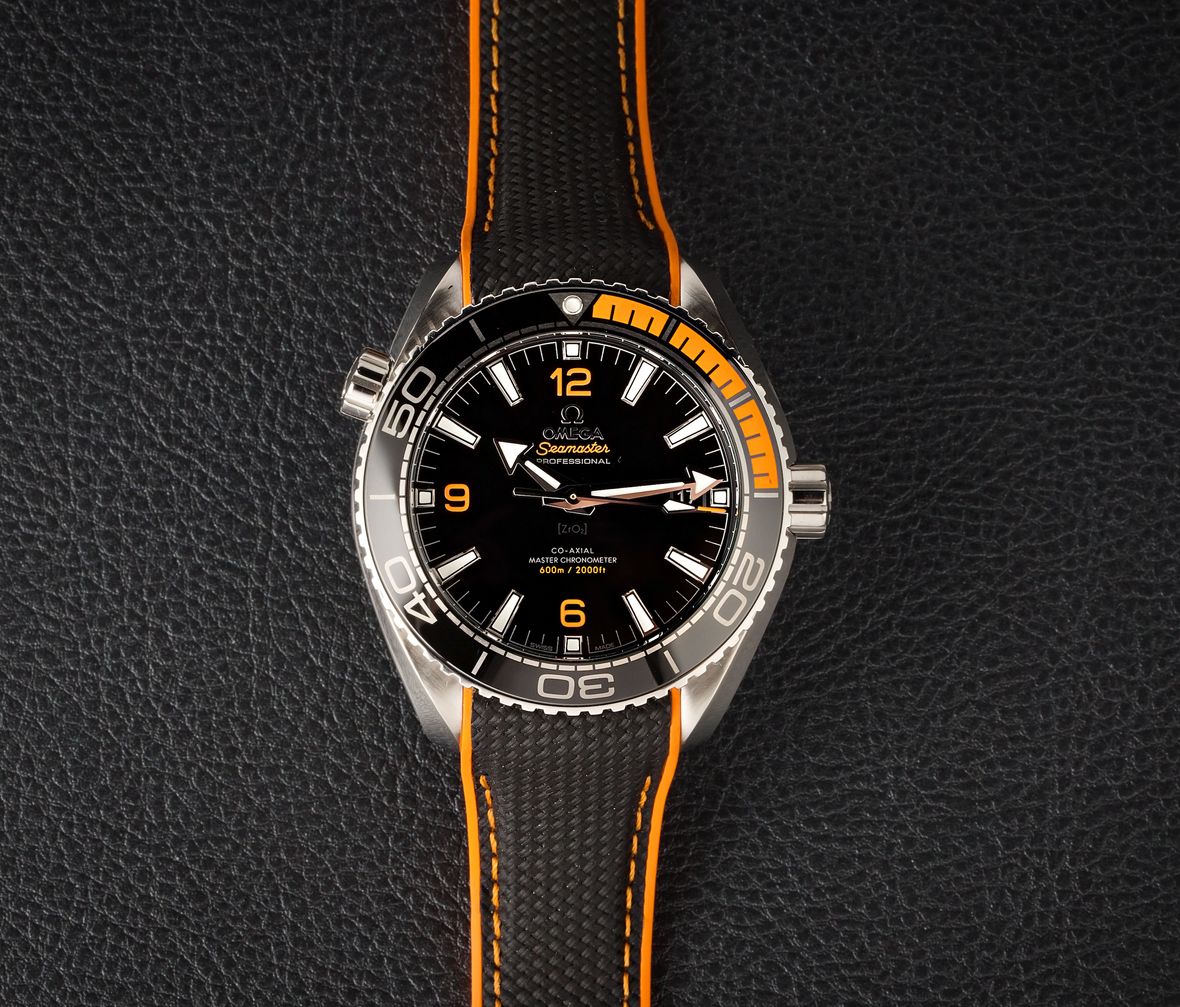 Key Features:
Key Features:
- Year of Introduction: 2005
- Multiple case sizes and material options
- 600 meters of water resistance
- Unidirectional timing bezel
- Helium gas escape valve
- Date Display
- Chronograph and GMT models available
Learn more about this history of the Omega Seamaster Planet Ocean collection right here.
A dive watch dialed up to 11, the Omega Seamaster Planet Ocean 600M series doubles the water-resistance of the classic Seamaster Diver 300M. First released in 2005, Omega Planet Ocean watches are a collection of highly-capable professional dive watches and among the first Omega Seamaster models to be fitted with Co-Axial movements.
The Planet Ocean is one of the more recent additions to Omega's catalog, having only first joined the lineup in 2005. Technically speaking, the Omega Planet Ocean is one of the numerous sub-collections that make up the greater Seamaster lineup. However, what separates the Planet Ocean apart from both of its Seamaster dive watch siblings is the fact that it doubles the already-ample 300-meter depth rating and offers users a whopping 600-meters (2,000 feet) of water resistance. As you would expect from a model that is even more dive-worthy than Omega's other professional divers, the Seamaster Planet Ocean includes all of the obligatory dive watch features, such as a helium escape valve and clasp fitted with a wetsuit extension.
The remarkably diverse Omega Planet Ocean collection now comprises 121 models and includes something for pretty much everyone. Cases can be found in a variety of sizes and can be crafted from stainless steel, two-tone steel and gold, solid gold, titanium, and even ceramic. The collection has also provided a platform for Omega to bring out new materials, with a number of pieces available featuring colored ceramic cases and Liquidmetal bezels. From smaller all-white models with diamond-encrusted bezels to large and imposing 45.5mm pieces with purpose-built aesthetics, the Planet Ocean sub-collection is now one of Omega's most diverse.
As a more premium offering within the greater lineup of Omega dive watches, the Planet Ocean collection is available in a number of different configurations, including both chronograph and GMT formats. In addition to a number of different case sizes and colorways, the Omega Seamaster Planet Ocean is also available in a range of different materials, including stainless steel, 18k gold, titanium, and even colored ceramic. The Planet Ocean is Omega's most modern and feature-packed range of sports watches that offer high-tech materials, bold aesthetics, and chronometer-certified movements fitted with Co-Axial escapements. While these bold and high-tech Omega Planet Ocean watches were originally designed specifically for scuba diving, their robust designs and practical feature sets make them excellent options for anyone looking for a tough and feature-packed, no-compromises sports watch.
Alongside the standard time-and-date models, there are also GMT variations and a host of chronographs, with each one offering the collection's signature arrow hands, ratcheted rotating bezels, helium escape valves, and Master Chronometer Co-Axial movements. There is a strong Bond connection here too. Daniel Craig can be seen wearing a Planet Ocean in a number of his movies, starting with the ref. 2900.50.91 in Casino Royale. Limited editions commemorating his films have followed.
Omega Seamaster Bullhead (2 Models)
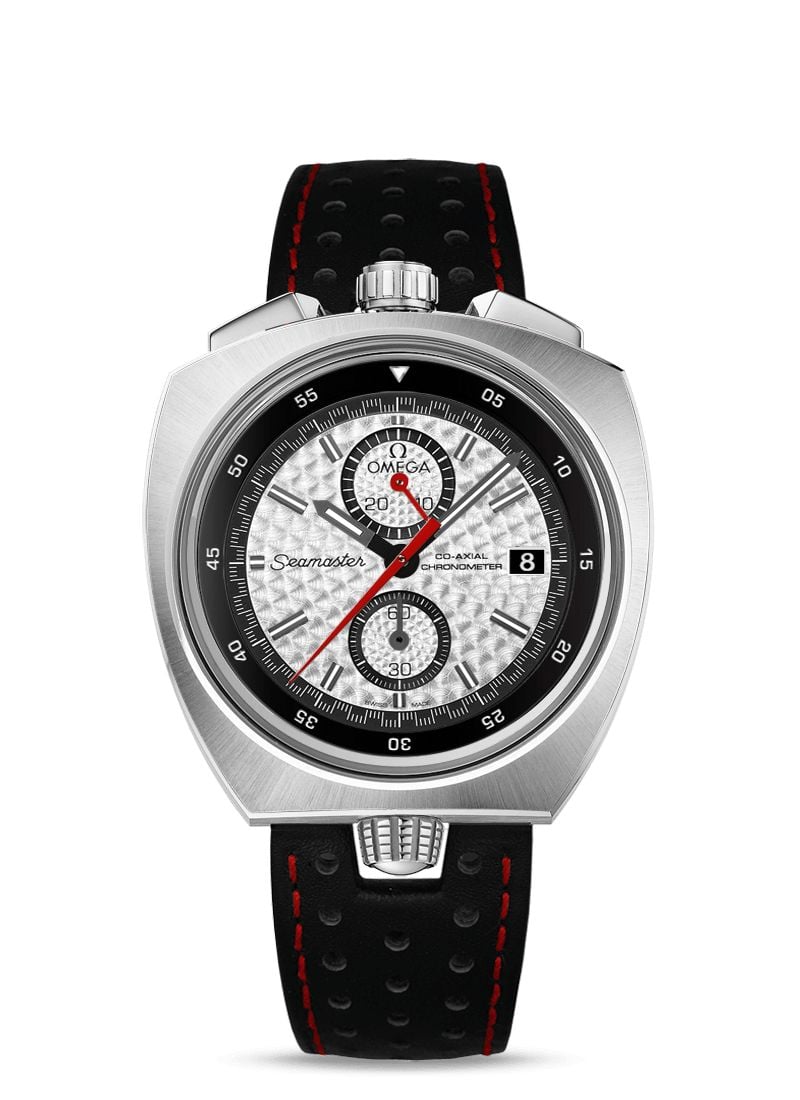
Key Features:
- 39mm case diameter
- Chronograph functionality
- Top-mounted crown and pushers
- Internal rotating bezel
- Vintage-inspired aesthetics
Omega is quite proud of its heritage, and this update of a quirky vintage classic is a world away from the other sub-collections in the Seamaster range. While 1969 original was officially called the Omega Seamaster Driver Chronograph, the 'Bullhead' nickname has stuck for this reissue from 2003, for obvious reasons. With its inverted triangular case, topped with two pushers that resemble horns, it does indeed look like the head of a bull.
Those retro pieces have gone on to become cult favorites, and the modern-day versions are tipped to do the same. A rotating inner 12-hour bezel is controlled by the crown at 6 o'clock, and there are two variations in total (one with a silver dial, the other with a black one), with each one limited to just 669 pieces. The Seamaster Bullhead may not be Omega’s most famous chronograph (we’ll get to that) but it is certainly the most distinctive. An oddity, but a wonderful one, the Omega Bullhead is a real standout.
Omega Seamaster Ploprof 1200M (10 Models)
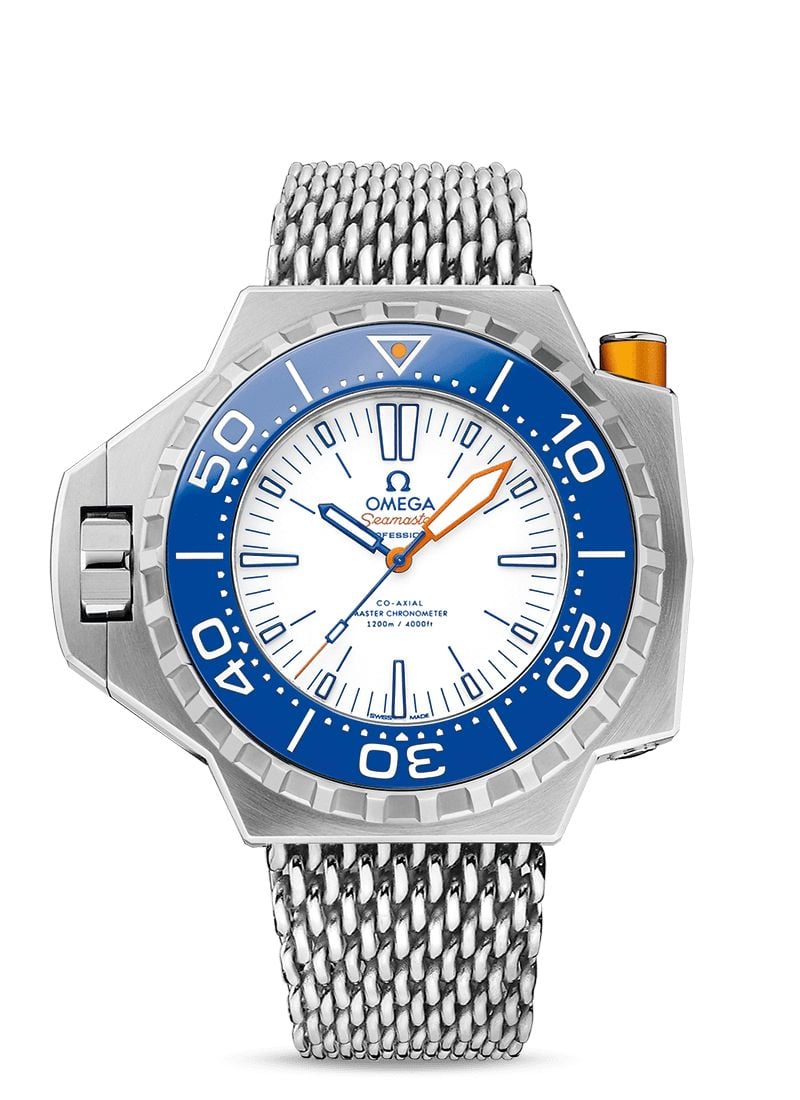
Key Features:
- 55mm x 48mm case
- Push-button bezel locking mechanism
- 1200 meters of water resistance
- Rotating timing bezel
- Helium escape valve
If you know the story of Rolex's dive watches, you will have almost certainly heard of COMEX. A French deep-sea saturation diving company, COMEX was the one responsible for commissioning both the Rolex Sea-Dweller (which led to the development of the helium escape valve) as well as the first of Omega's Ploprofs, the Seamaster Professional 600 in the 1970s.
The various watch brands all had the same problem to overcome: build a timepiece that is not only strong enough to survive the crushing pressures of the deep, but also the ascent back to the surface. One of the main problems was helium, a necessary addition to the breathing gases used by divers at great depth, but one which crept inside the cases of the crew’s watches. As they returned to the surface, the helium molecules would expand, blowing the crystals off their watches.
Rolex came up with an automatic valve as a way to safely release the gas, while Omega went another direction entirely and created a watch so impenetrable that the helium couldn’t find a way inside in the first place. The end result was a truly massive, slab-sided Kraken of a watch, loved by professionals but somewhat of a commercial failure. However, as with the Bullhead, time has changed people's tastes, and the Ploprof’s eccentricities are now more revered than shunned.
In 2016, Omega relaunched the watch for a new generation, a behemoth measuring 55mmx48mm and rated waterproof to an incredible 1,200m. The 10 models are offered in both stainless steel and titanium, with the top of the line example accented with Sedna gold around the bezel edge and on its heavily protected crown. In the sometimes cookie-cutter world of dive watches, there is little to outshine an Omega Seamaster Ploprof.
Omega Seamaster Aqua Terra (325 models)
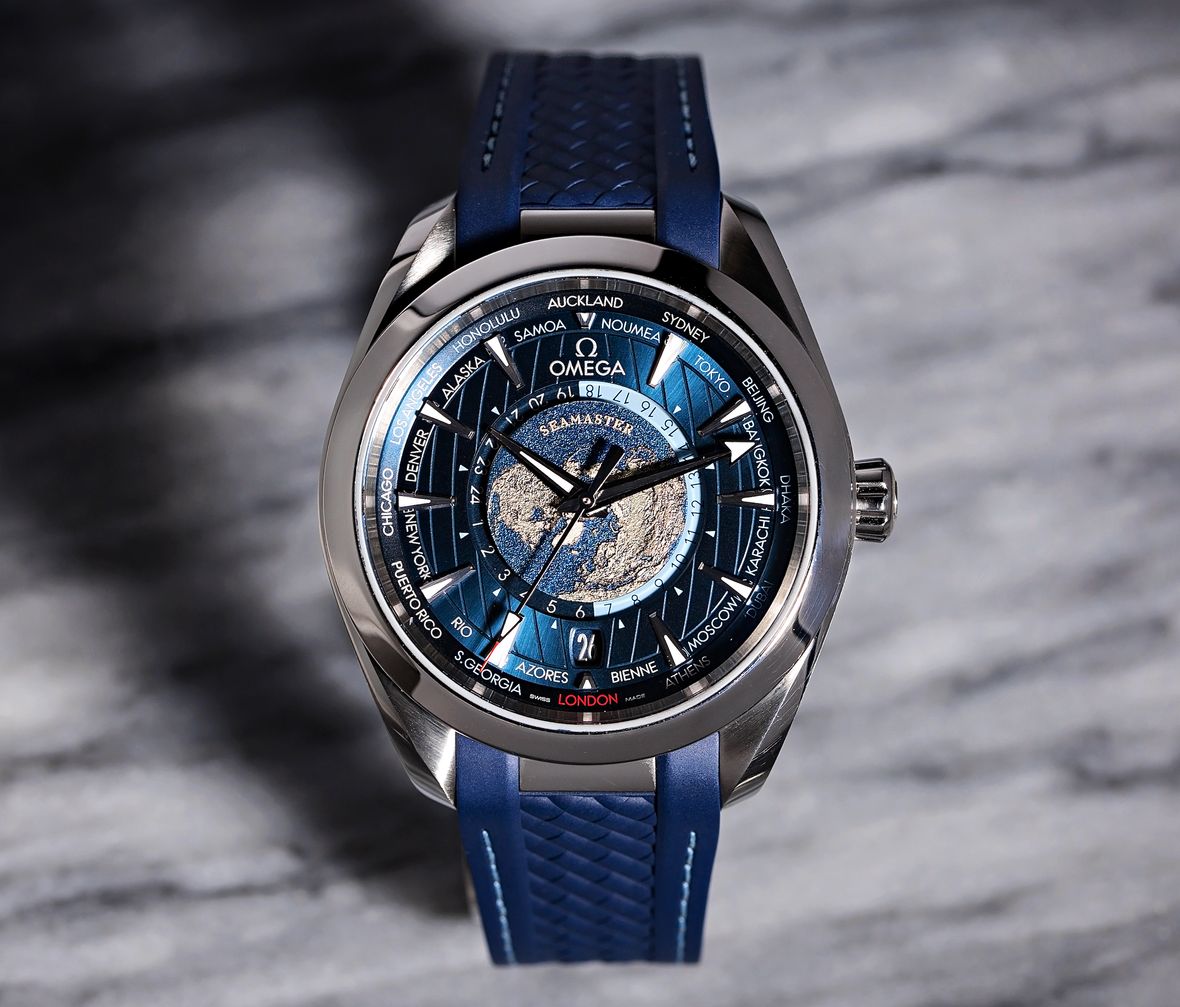 Key Features:
Key Features:
- Year of Introduction: 2002
- Multiple case sizes and material options
- 150 meters of water resistance
- Fixed bezel without markings
- Screw-down winding crown
- Nautical-inspired dial aesthetics
- Multiple different configurations available
Check out our complete Omega Seamaster Aqua Terra buying guide right here.
One of those sub-collections that stretches the textbook definition of what could be considered a sports watch, the Omega Seamaster Aqua Terra series could really be seen as a collection of dress watch models that are more than capable of handling themselves in the water. In that way, perhaps it is best to look at the Omega Aqua Terra collection is as a modern-day continuation of the very first Seamaster watches from 1948.
Just like the Planet Ocean, the Omega Aqua Terra is another part of the greater Seamaster collection. However, while the Planet Ocean doubles down on its dive watch capabilities, the Aqua Terra goes in a different direction entirely and offers a less professionally oriented take on a luxury sports watch. While the Seamaster 300, Planet Ocean, and Diver 300m are all purpose-built dive watches, the Aqua Terra is not specifically built for a life spent underwater. As its "Aqua Terra" name suggests, the Omega Seamaster Aqua Terra is equally at home on land as it is in the water, and it foregoes the rotating timing bezels of its siblings in favor of a refined and versatile design that can effortlessly transition from formal to casual attire without skipping a beat or catching on your shirt cuff. However, despite its more dressy and elegant appearance, all Omega Aqua Terra watches still offer users a more-than-adequate 150-meter depth rating, meaning that they are more than capable of accompanying you both in and underwater.
Debuting in 2002, the Aqua Terra series is now among the brand's most diverse and contains some 325 different models in it, including both men’s and ladies' watches, and models powered by manual, automatic, or quartz movements. Additionally, there are time-only, time-and-date, day-date, chronograph, GMT, and even GMT Worldtimer models that have stunning laser-ablated relief maps of the globe.
The Omega Seamaster Aqua Terra collection also contains the >15,000 Gauss models, which are truly antimagnetic and feature movements constructed from 100% non-ferrous components. However, while the watches are particularly diverse, there are design consistencies running throughout, most notably with the twisted lyre lugs and the majority of the dials having a horizontal striped 'teak' pattern, inspired by the decking on luxury yachts.
As the Omega Aqua Terra is designed to be a bit of a "jack of all trades" kind of sports watch, it does not include any specific features or complications that would make it especially tailored to one single sport or environment. However, the Aqua Terra is available with a wide range of different complications, including time and date, chronograph, GMT, and even worldtimer configurations (among others). Additionally, the Omega Aqua Terra is available in a shockingly wide range of case sizes from a compact 28mm model all the way up to a massive 49.5mm version, and it can also be found in a number of different case materials, including stainless steel, two-tone steel and gold, full 18k gold, and titanium. On top of that, since the Aqua Terra is intended to be more than just a utilitarian sports watch, the collection is also home to ample options that are adorned with diamonds and other precious gemstones, and between these iterations and the more tool-like stainless steel models, this range of watches offers one of the most diverse aesthetics in Omega's entire portfolio.
Omega Seamaster Railmaster (7 models)
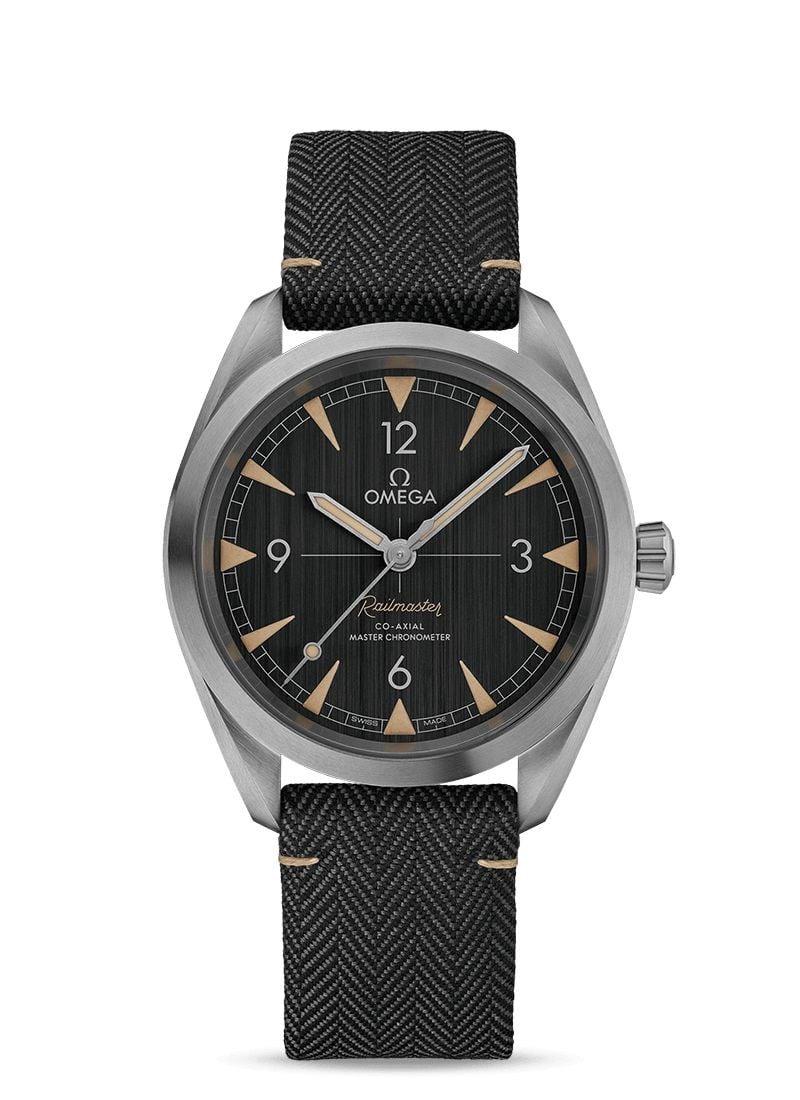
Key Features:
- 40mm case diameter
- Antimagnetic movement
- Time-only display
- Fixed bezel without markings
- Vintage-inspired aesthetics
Why the Omega Railmaster is now part of the Seamaster line is a bit of a head-scratcher, but it is an important name in Omega's history nonetheless. The original was one-third of the trilogy of professional watches from 1957, launched alongside the first Seamaster 300 and the Speedmaster. However, the original was short-lived and was discontinued in 1963 after disappointing sales - suffering from the same lack of glamor as its direct competition, the Rolex Milgauss and the IWC Ingenieur.
Back then, the Railmaster's party piece was its resistance to magnetic interference, something which was a relatively new phenomenon in the 1950s. Utilizing a soft iron inner cage to shroud its caliber, it could guard up to fields of 1,000 gauss. When it was brought back in 2003 after a 40-year absence, the world had moved on. Now, with the current generation being powered by Omega's Master Co-Axial movements that are antimagnetic by nature, the current Omega Seamaster Railmaster is able to shrug off more than 15,000 gauss, even without the use of an internal cage.
While these up-to-date versions still don't sell in the same sort of numbers as other watches in the Omega Seamaster or Speedmaster families, they still have an enthusiastic fan base and are an attractive and versatile watch that is perfect for everyday wear and use.
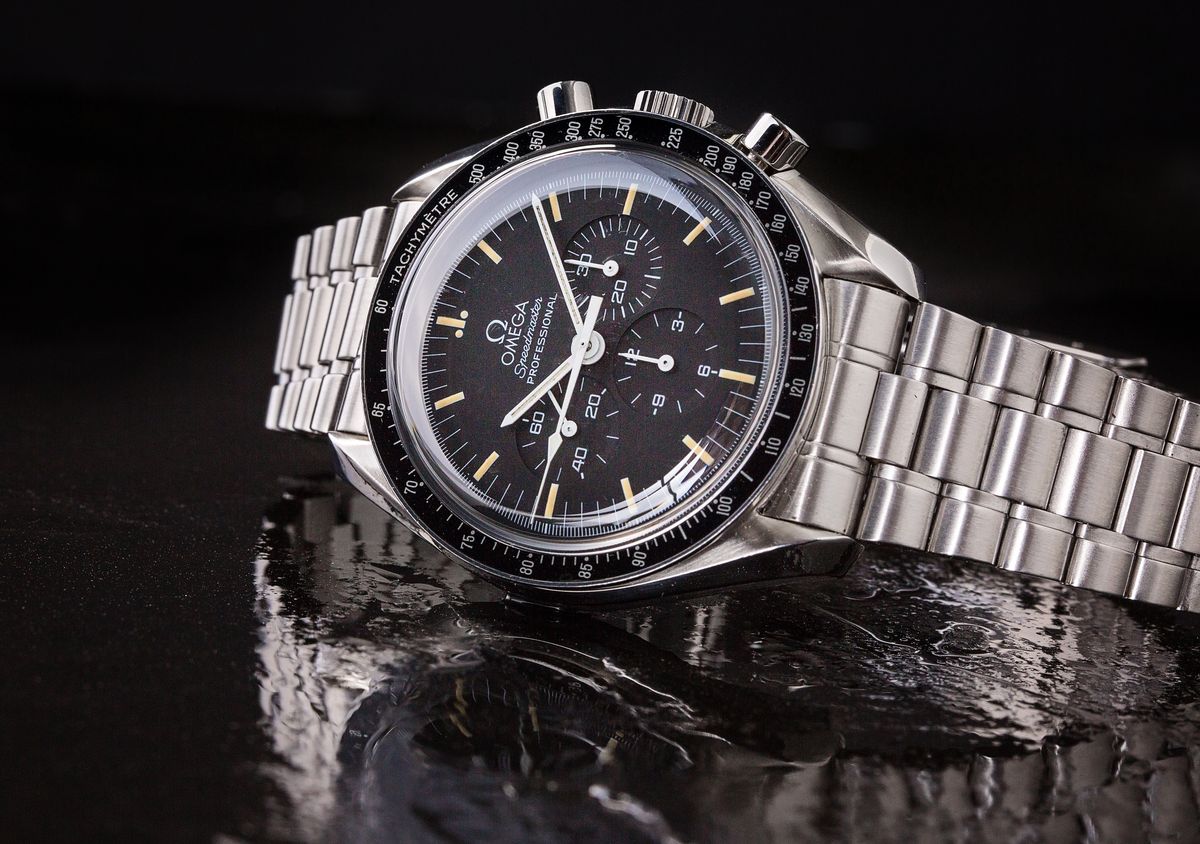 The Speedmaster is Omega's collection of chronograph watches.
The Speedmaster is Omega's collection of chronograph watches.
The Omega Speedmaster Collection
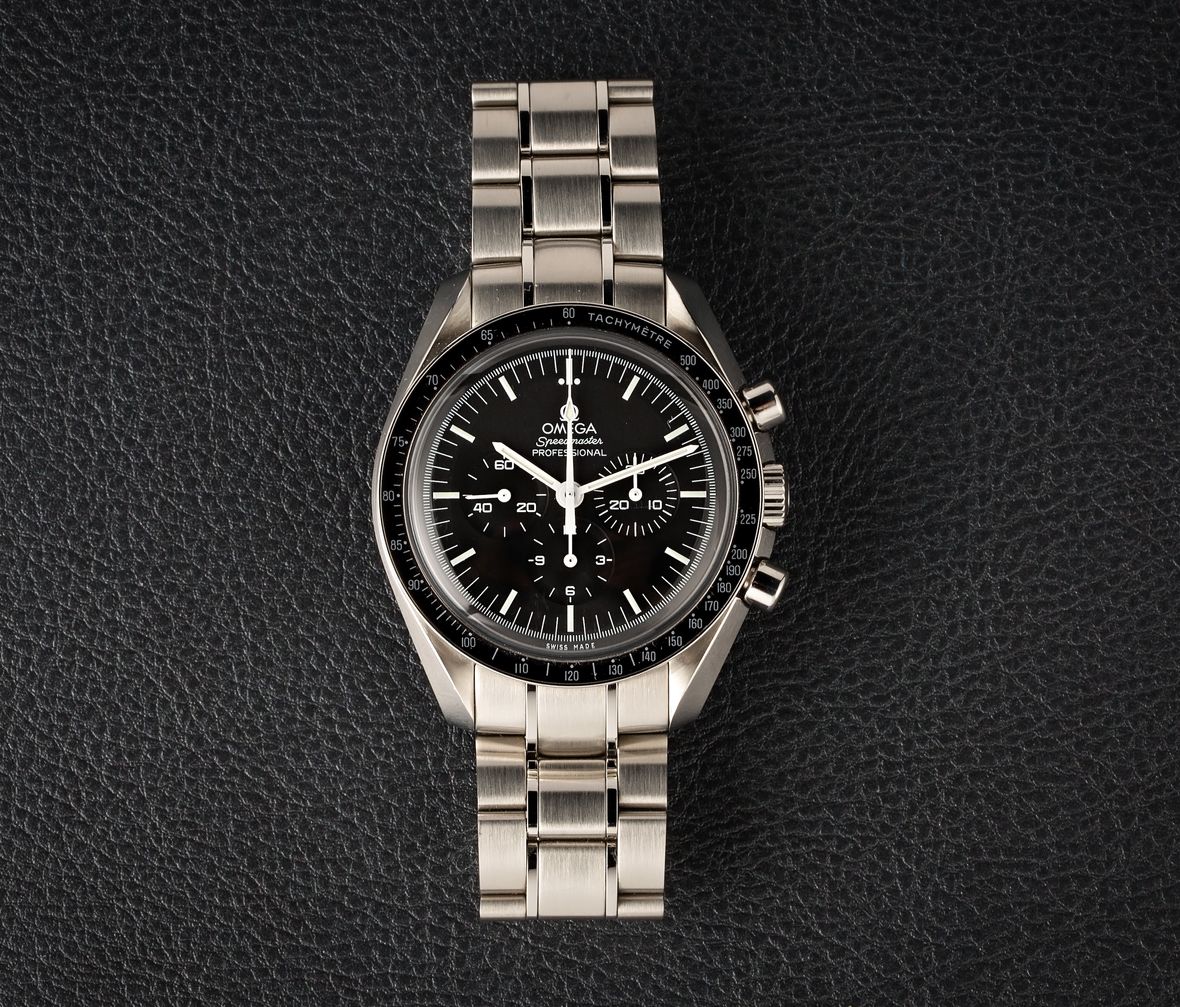
Speedmaster Key Features:
- Year of Introduction: 1957
- Key Features: External tachymeter bezel; Chronograph functionality
- Water Resistance: 50 Meters / 167 Feet
Click here for our Ultimate Buying Guide on the Omega Speedmaster.
It would be absolutely impossible to have a meaningful discussion about Omega sports watches without mentioning the Speedmaster. First launched in 1957 alongside the inaugural Seamaster 300 and Railmaster models as part of a trio of purpose-built 'professional' watches, the Omega Speedmaster was a chronograph wristwatch originally developed for the world of automotive racing (hence its Speedmaster name), and it was the first to move its tachymeter scale from the periphery of its dial to its external bezel. However, the watch's racing chronograph origins were soon eclipsed by its associations with space travel, when a privately purchased Speedmaster made it into space aboard the 'Sigma 7' mission. From here, the Omega Speedmaster would go on to become the official flight-certified watch of NASA and by 1969, a Speedmaster had become the first watch worn on the moon, forever cementing its place in watchmaking history.
Over the years, the Omega Speedmaster collection has grown and expanded into a diverse range of chronograph-equipped sports watches, and you will even find highly advanced quartz models that feature hybrid analog/digital displays that offer their users unparalleled functionality. Additionally, on the other end of the Omega Speedmaster spectrum, you will find a version of the classic Moonwatch that is the modern-day equivalent of the model that was first worn on the surface of the moon, complete with a Hesalite (acrylic) crystal and traditional manual-wind movement. The Omega Speedmaster is widely considered to be one of the true undisputed legends of horology, and regardless of the specific model or reference that you choose, you will be getting one of the best and most historically significant sports watches of all time.
There are very few names in horology more evocative than the Omega Speedmaster, and there is absolutely no other watch that is able to make the same claims as Omega's legendary chronograph. Just like with the Submariner vs. Seamaster debate, you will have no trouble finding those willing to argue all day over whether the Speedy or the Daytona is the greatest mechanical chronograph of all time, but there isn’t room to go into that here. With that in mind, the fact remains that only one has been to the moon, and it is not the Rolex.
When the original Speedmaster emerged as part of the 1957 Professional Collection, a trip into space was probably the last thing on Omega’s mind. The focus was on producing a chronograph for planet Earth, and the ref. CK2915 was certainly that. Driven by the now celebrated Caliber 321 movement, the 39mm model was able to measure down to 1/5th of a second, and the watch was the first to move the tachymeter scale to the bezel, freeing up vital real estate on the dial.
With everything the Omega Speedmaster had going for it, it was little wonder that it became the watch of choice for many astronauts, resulting in the Speedy catching the attention of NASA a few years later. The follow-up to the original model, the ref. CK2998 was astronaut Wally Schirra’s personal watch that he wore when he orbited the planet in 1962 as part of the Mercury-Atlas mission. In 1964, NASA put several watches (including the Omega Speedmaster) through a series of brutal tests, and the Speedy was the only one to pass them, becoming NASA’s first flight-qualified timepiece in 1965.
On July 20th, 1969, Buzz Aldrin stepped onto the lunar surface wearing his Omega Speedmaster, and it immediately won another title; the Moonwatch. As we saw with the Seamaster, the Omega Speedmaster line has also diversified wildly over the subsequent decades. However, the contemporary collection has a more cohesive nature to its styling, without nearly as many peculiarities or inconsistencies. Below is an overview of the current Omega Speedmaster range.
Omega Speedmaster Professional Moonwatch (46 Models)
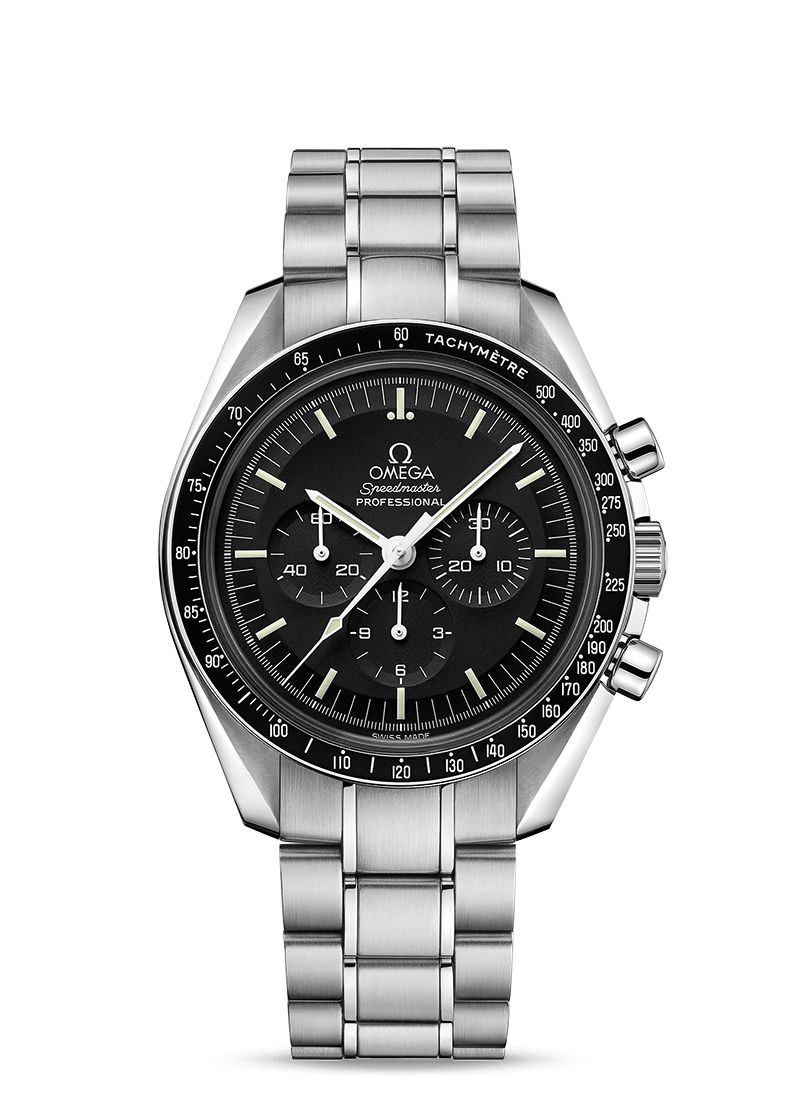
Key Features:
- Multiple sizes and options available
- Chronograph functionality (tri-compax)
- External tachymeter bezel
- Luminous hands and hour markers
- Cases with 'lyre' lugs
Check out the full history of the Omega Speedmaster here.
There can only be one place to start. All six lunar missions had an Omega Speedmaster on board, and all served with immaculate distinction. Omega was even given the Silver Snoopy Award for its Speedmaster playing a crucial role in bringing home the stricken Apollo 13 spacecraft in 1970. Among the 46 different Moonwatch models now currently available, there is even a pair (one in steel, the other in platinum) powered by a resurrected version of the Caliber 321 movement that powered the original flight-qualified Speedmaster models, now dusted off and revived for a new generation.
Elsewhere, the 42mm manual-wind chronograph with its black dial and bezel is an undeniable icon of horology, available today with either a sapphire crystal or a nostalgia-drenched Hesalite crystal, just like the original flight-qualified models. Far from being stuck in the past, there are also plenty of modern-day complexities and materials. There are a total of 13 Speedmaster models with moonphase complications, and you won’t find a more apt home for them than the Speedmaster Moonwatch.
The various 'Side of the Moon' sub-groups are constructed with all-ceramic cases in either black, white, grey, or blue. Additionally, a couple of limited editions pay tribute to the 50th anniversary of the Apollo 11 landings, with one in Omega’s proprietary Moonshine gold that features a splash of palladium to ensure its color, alongside a stainless steel model with a laser-engraved medallion of Aldrin’s descent from the lunar module over the 9 o’clock counter. Overall, any serious watch fanatic needs to have at least one Omega Speedmaster Moonwatch (of some description) in their collection.
Omega Speedmaster '57 (19 Models)
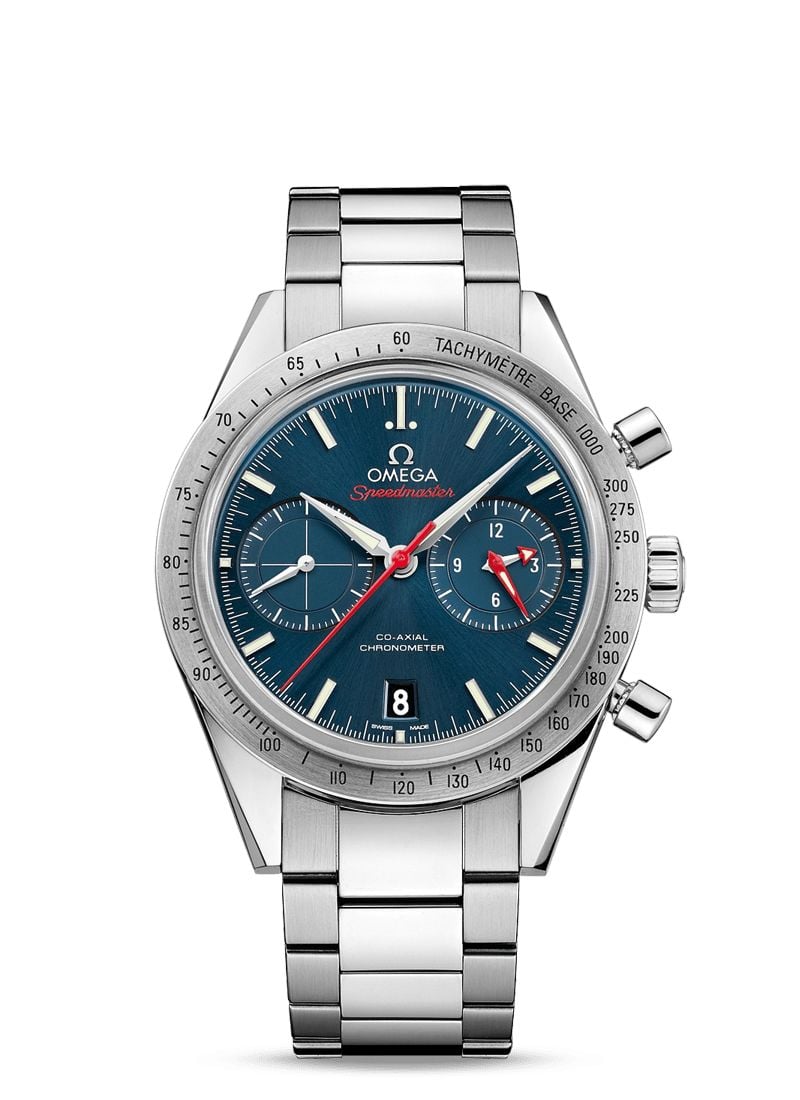
Key Features:
- 41.5mm case diameter
- Chronograph functionality (bi-compax)
- External tachymeter bezel
- Cases with 'straight' lugs
- Vintage-inspired aesthetics
Coming from a brand that is never afraid to return to its roots, the Omega Speedmaster '57 draws deeply from its ancestors and gives you the chance to wear a piece of history on your wrist, albeit one with the very latest technology inside. The models are all 41.5mm, which is slightly larger than the original ref. CK2915 and geared towards a present-day audience.
Much of the general aesthetics from the original model are present, despite the various modern upgrades such as sapphire crystals and Co-Axial movements, which require a different bi-compax dial layout. The majority of Speedmaster '57 models are offered in stainless steel, but there are also a number of solid gold, two-tone, and titanium examples.
There are three main dial color options (black, white, or blue), along with a limited edition ‘Rory McIlroy’ all gold piece with a matching yellow gold dial to celebrate the pro golfer's career. Regardless of the specific model or materials, all Omega Speedmaster '57 watches (with the exception of the vintage recreation from the anniversary Trilogy collection) are powered by Omega's family of in-house, self-winding, Co-Axial movements.
Omega Speedmaster Mark II (3 Models)
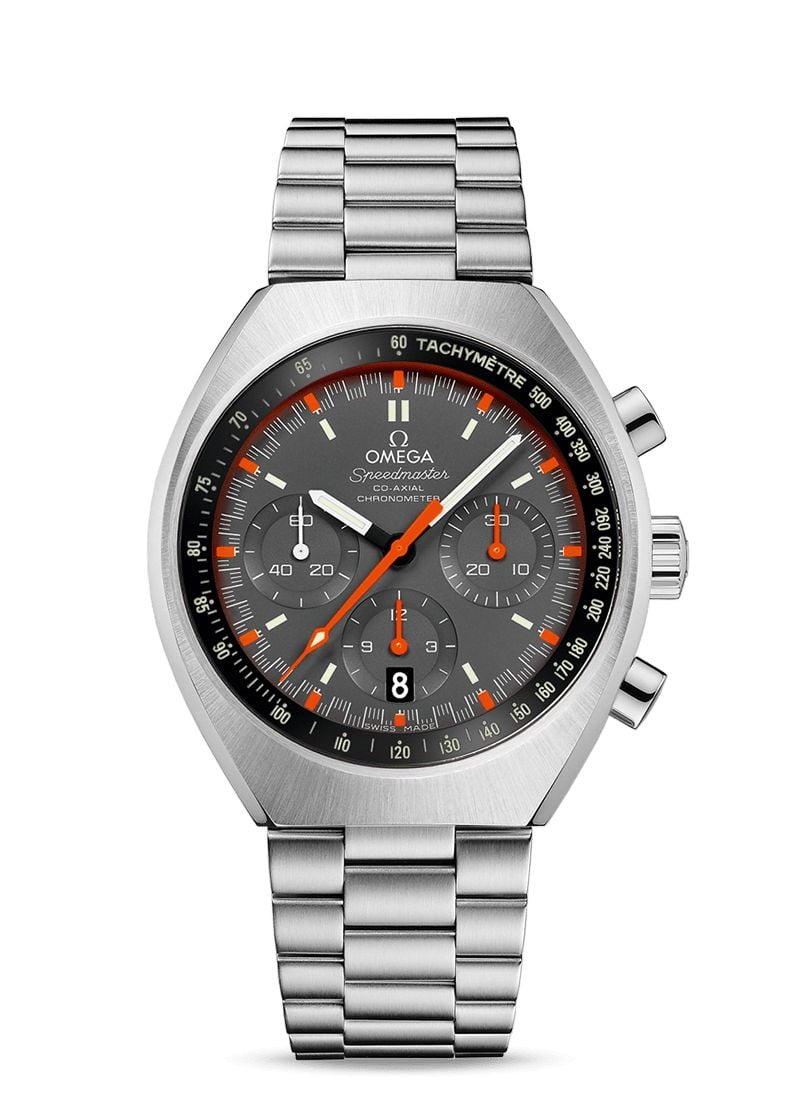
Key Features:
- 42.4mm case diameter
- Chronograph functionality (tri-compax)
- Internal tachymeter bezel
- Barrel-shaped case
- Vintage-inspired aesthetics
How do you follow a legend? As early as 1969, with the classic Speedmaster still fresh from its moonwalk, Omega was already setting about updating the watch for the dawn of a new decade. The Speedmaster Mark II arrived with a futuristic (in a very seventies sort of way) barrel-shaped case, but still with the same hand-wound Caliber 861 that was found inside the regular Speedmaster Moonwatch.
The original Omega Speedmaster Mark II was discontinued in 1972, having never achieved anywhere near the same degree of popularity as the originator - the same fate that befell the Mark III, Mark IV, and Mark V that followed. However, as with the cyclical nature of these things, Omega reintroduced the Speedmaster Mark II in 2014 as an homage, a beautiful throwback to that space race era.
Today's versions are all powered by the Omega Co-Axial Caliber 3330 movement, which s housed inside a 42.4mm case, crafted from either stainless steel or a two-tone version in steel and 18k Sedna gold. These up-to-date models have just the right amount of neo-vintage chic to be a genuine alternative to the archetypal Omega Speedmaster and are absolutely perfect for those after something just a little bit different.
Omega Speedmaster Racing (10 models)
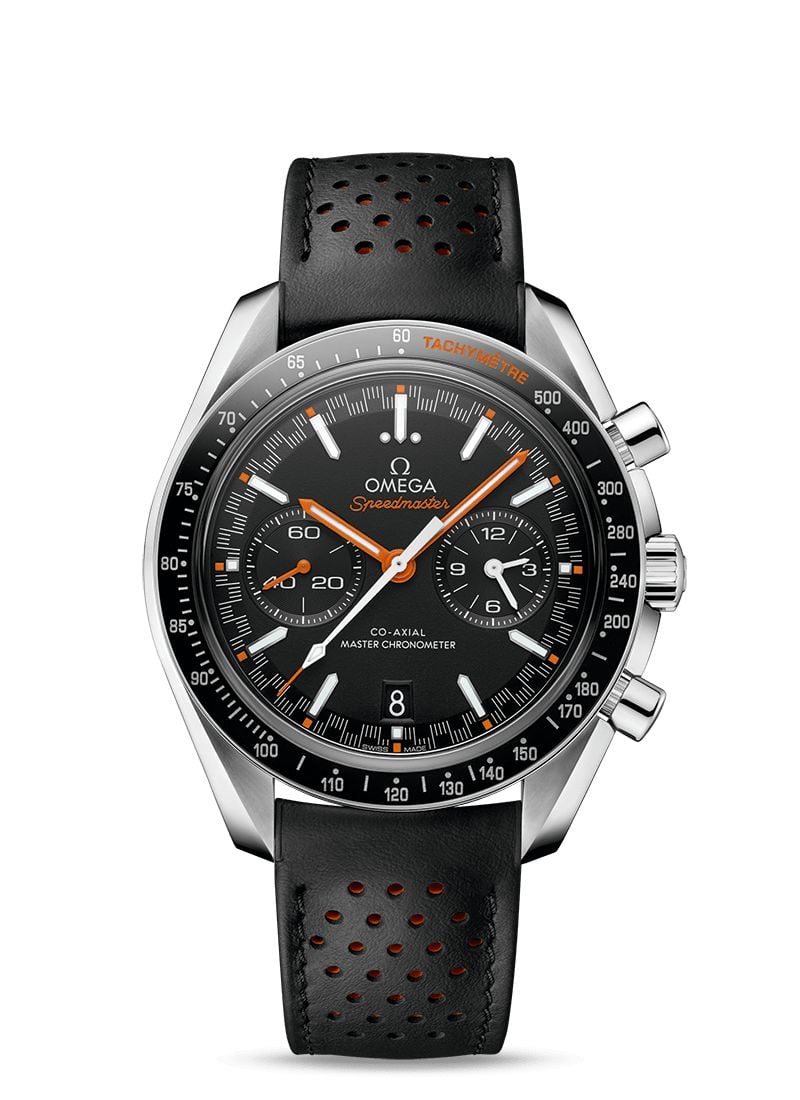
Key Features:
- 44.25mm case diameter
- Chronograph functionality (bi-compax)
- External tachymeter bezel
- Case with 'lyre' lugs
- Racing-inspired aesthetics
When you read Speedmaster, you probably think Moonwatch. The link between the Speedy and its space missions is so strong and defined, it can sometimes be easy to forget that the original model was designed for the race track. However, Omega has never forgotten, and there has been a racing dial variant in the Speedmaster lineup from as far back as 1968.
The latest iterations stem from 2017 and are physically larger than the classic Moonwatch, with cases that measure 44.25mm in diameter. There are currently 10 different models to choose from, including several pieces with orange handset and bezel accents (a real favorite from yesteryear); however, the big news revolves around the movement used to power the new Omega Speedmaster Racing models.
A self-winding column-wheel controlled mechanism with co-axial escapement, the Caliber 9900 (or Cal. 9901 in the solid gold version) powers the various Speedmaster Racing watches and was among the first of Omega’s chronograph calibers to win the new METAS Master Chronometer certification. Considered something of a work of art, its silicon balance spring helps to leave it resistant to magnetic fields of up to 15,000 gauss, while the more luxurious version, the Caliber 9901 is fitted with an 18K Sedna gold rotor and balance bridge.
Omega Speedmaster 38 (20 Models)
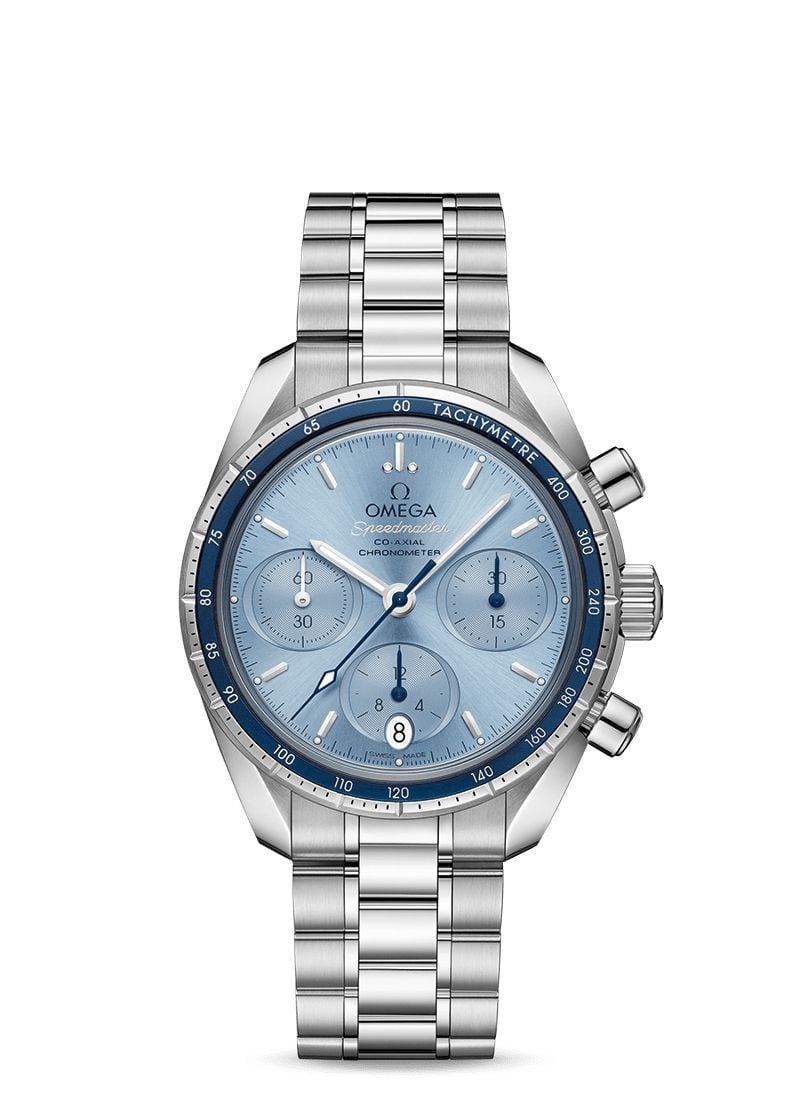
Key Features:
- 38mm case diameter
- Chronograph functionality (tri-compax)
- External tachymeter bezel
- Case with 'lyre' lugs
- Oval-shaped sub-dials (most models)
Sometimes referred to as the Speedmaster Reduced (as this was the name for the original range of smaller Speedmaster watches), the Omega Speedmaster 38 models are a perfect midsize option aimed at both men and women. As a whole, the Speedmaster 38 range is undoubtedly a bit softer and more refined than the overtly masculine watches that make up some of the other Speedmaster sub-collections, and they offer a few unique touches to differentiate themselves from the herd.
The sub-dials on the majority of Omega Speedmaster 38 models have an unusual oval shape, bringing to mind certain references in the De Ville series, and which give the dial a greater sense of depth. There are also some new colorways that are not present in the rest of the Speedmaster range, with an attractive ice-blue edition among the more outspoken and unique pieces.
Diamonds also make an understated appearance here and there, ringing the outer edges of some of the bezels, and underlining that these are at the more dressy end of Omega's sports watch spectrum. Regardless of the specific model or materials, all Omega Speedmaster 38 watches are powered by the Caliber 3330 movement, complete with a silicon balance spring and the brand's signature Co-Axial escapement.
Omega Speedmaster Skywalker X-33 (2 Models)
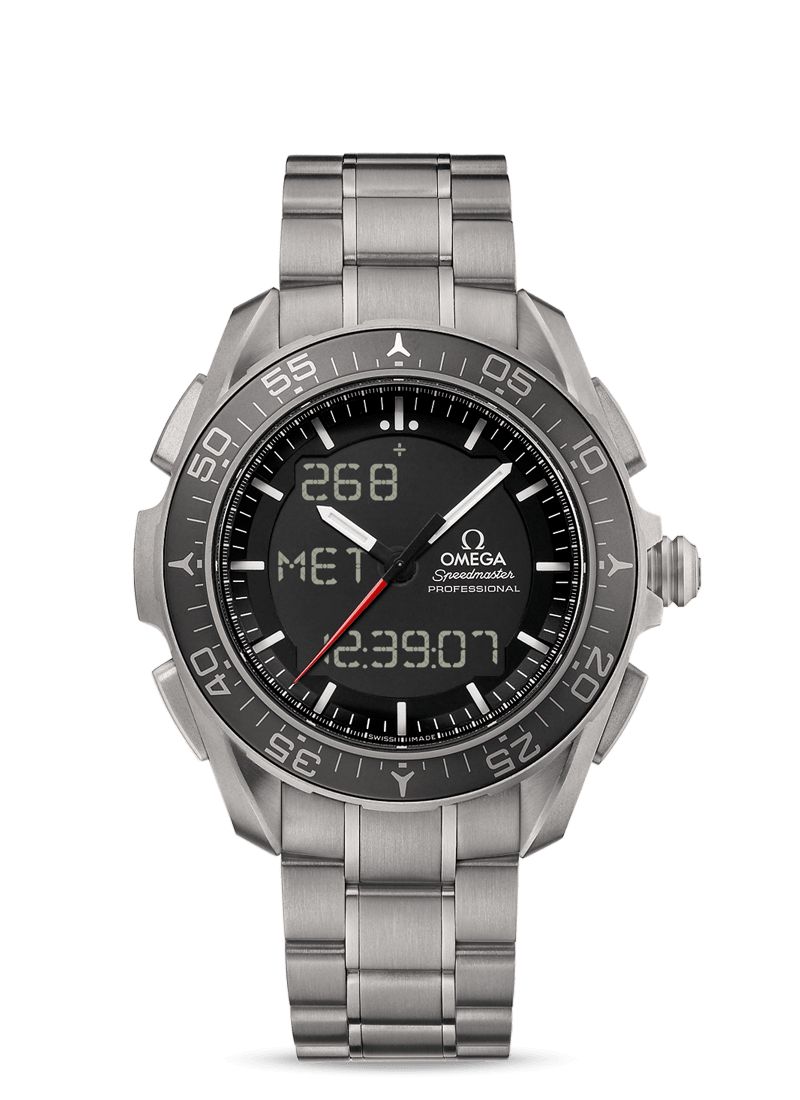
Key Features:
- 45mm case diameter
- Hybrid analog/digital quartz movement
- Advanced astronaut-specific functionality
- Titanium construction
- Digital pushers on both sides of case
Finally, as the next logical step in Omega's pioneering journey, we have the Omega Speedmaster Skywalker X-33. The classic Moonwatch will always have its place as one of horology's greatest accomplishments, but as advancements in timekeeping entered the digital era, the requirements for an astronaut's watch evolved past what could be offered by a traditional mechanical movement.
Omega launched the first Speedmaster X-33 in 1998 and originally called it the 'Mars Watch' in the initial advertising materials. The current, third-generation was released in 2014 and is (as you might imagine) a world away from the original Omega Speedmaster Moonwatch as we know it today. Co-designed by real-life astronauts and flight-qualified by the European Space Agency, the current Omega Speedmaster Skywalker X-33 runs on an analog/digital hybrid quartz movement and features a titanium case, sapphire crystal, and ceramic bezel.
The 45mm quartz watch can display three different time zones on its LCD display, as well as a chronograph, a timer, MET (Mission Elapsed Time), PET (Phase Elapsed Time), three alarms and a perpetual calendar. Fuelling all that is the thermo-compensated Caliber 5619 movement, thought to be accurate to well within +/- 25 seconds a year.
Yet, even though there may be few similarities with the classic Speedy, you can still see its underlying design DNA in the Skywalker X-33. The lugs are a little bit thicker, but they still have the trademark twist through them. The black on white detailing is there as it should be, and the whole thing has an elegant solidity that inspires confidence.
Will it become an icon like the Moonwatch? No, probably not. The LCD display is not able to withstand the ultra-cold temperatures found in outer space, and so the original manually-wound Omega Speedmaster still remains the only watch to be both flight-certified and qualified for EVA (use outside of a spacecraft, ie. spacewalks).
With a history that dates all the way back to 1848, Omega is one of the oldest names in watchmaking, and the brand has been producing purpose-built sports watches since the 1950s. While Omega's fortunes have been up and down in the past, today you won't find many other luxury manufacturers that are held in higher regard.
Omega's range has been consolidated with a confident and striking visual identity, and the brand's current collection of movements is acknowledged as some of the best and most advanced mechanical calibers in the industry. Omega's commitment to excellence has won it a whole new generation of fans, delighted by both cutting-edge innovations as well as the allure of their vintage-inspired nostalgia. Truly some of the best purpose-built watches in all of horology, Omega sports watches rank among the very best.
*Images courtesy of OMEGA